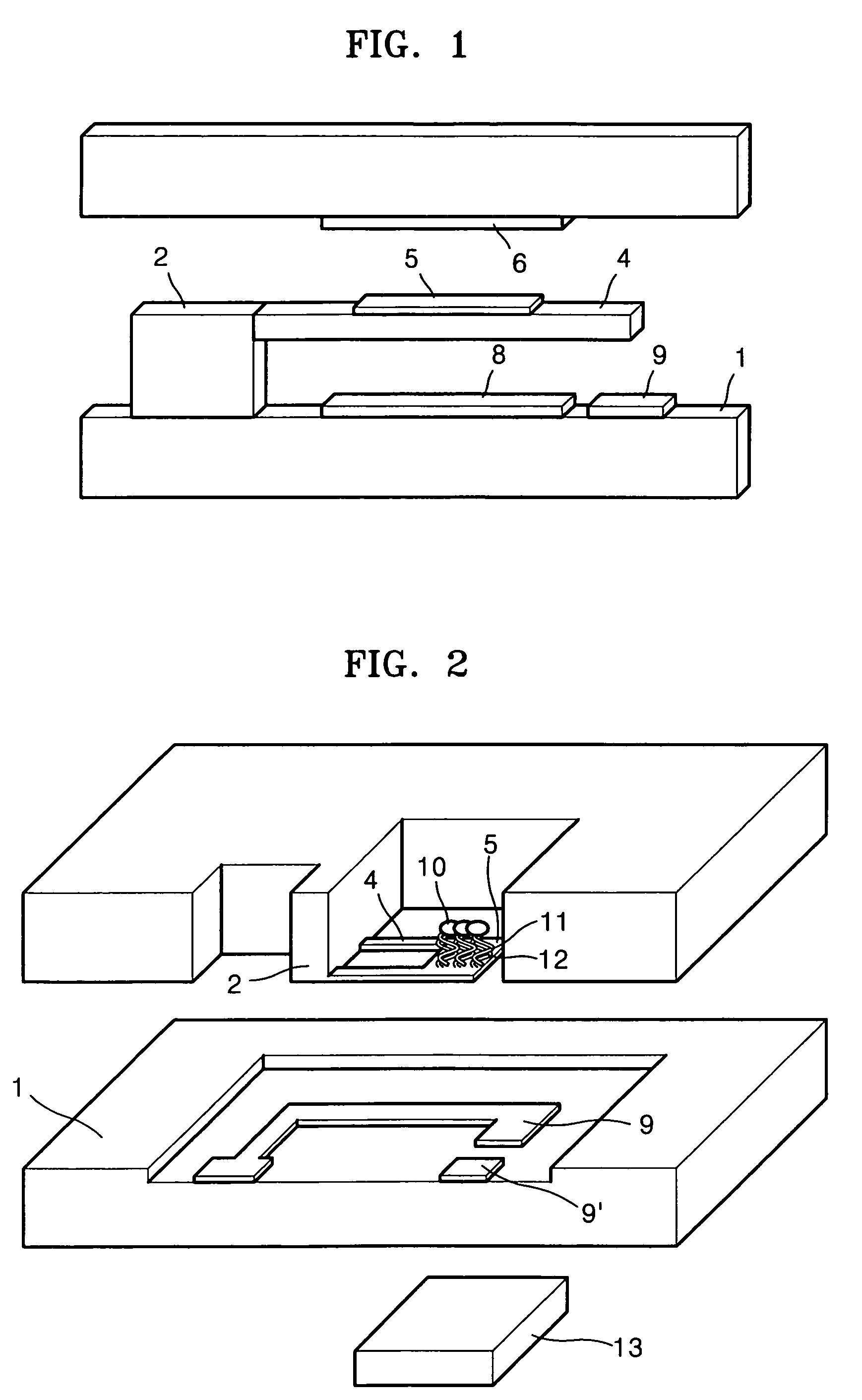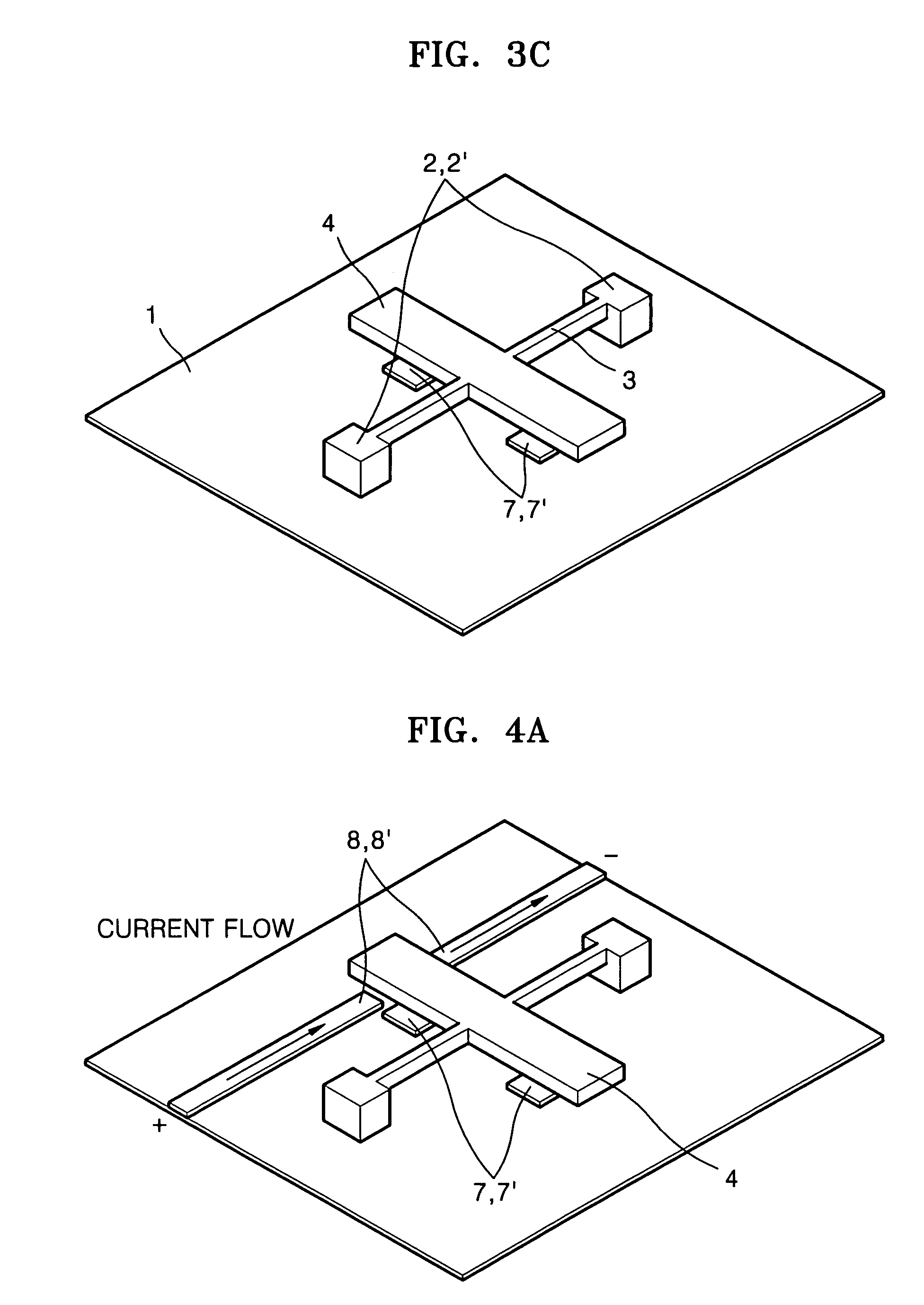Sensing switch and detecting method using the same
a technology which is applied in the field of sensing switch and detecting method using the same, can solve the problems of inability to digitally output, large system, and difficult miniaturization of equipment required, and achieve the effect of effectively removing background signals and being easily identified
- Summary
- Abstract
- Description
- Claims
- Application Information
AI Technical Summary
Benefits of technology
Problems solved by technology
Method used
Image
Examples
example 1
[0094]Torque was measured using the sensing switch illustrated in FIGS. 9A and 9B under the following condition: 80% non-specific binding to mismatched receptor (single mismatch receptor, hypothetically); immobilized 25 mer receptor DNA density of 2×1012 molecules / cm2; 100% hybridization with perfect matched DNA (25 mer); a receptor of 5′ SH-C6-AGATCAGTGCGTCTGTACTAGCACA 3′ (See A. Peterson, the effect of surface receptor density on DNA hybridization, Nucleic Acid Research 2001, 29, 24, pp 5163-5168).
[0095]The results of steady state analysis are described below.
[0096]Total effective charge (q)=reactive surface area x molecules / area×number of electrons / molecule×charge / electron=6×10−11 C;
[0097]the electric field=10V / (50×10 um)=2×105 N / C; and
[0098]Fe=1.2×10−9 N.
[0099]Accordingly, as described below, the sensor did not operate because the electrostatic torque, was smaller than the mechanical restoring torque.
[0100]Electrostatic Torque=Fe×40 μm=4.8×10−10 Nm
[0101]Restoring torque=9.22×10−...
example 2
[0109]In order to confirm whether the sensing switch shown in FIG. 10 can act as a switch, a simulation experiment was conducted in which a nucleic acid used as biomolecule was sensed using the apparatus illustrated in FIG. 9. (See A. Peterson, the effect of surface receptor density on DNA hybridization, Nucleic Acid Research 2001, 29, 24, pp 5163-5168). ANSYS 8.0 (obtained from ANSYS, Inc., USA) was used as a simulation program, a shell 93 (suited for large deflection) was used as an element, a beam was made of gold, young's modulus was 75 GPa (silicon˜169 GPa), poisson's ratio was 0.42, a density was 1.932×104 kg / m3 (silicon˜2.33 e3 kg / m3), the beam had a thickness of 1 μm, the relative permitivity of a buffer solution was 80, a gap between two electrodes was 100 μm, an applied potential was 10 V, an immobilized 25 mer receptor DNA density was 2×1012 molecules / cm2, 100% hybridization with perfectly matched DNA (25 mer) was performed, and a receptor used was 5′ SH-C6-AGATCAGTGCGTCT...
example 3
[0111]A force generated between the magnetic bead and the magnetic generation device that was sufficiently strong to move a switch but not greater than a binding force between the receptor and the ligand was measured using the sensing switch shown in FIG. 2
[0112]A BioMag® BM551 was used as the magnetic bead. Streptavidin as a ligand was bound to the surface of the magnetic bead. A neodium magnet was used as the magnetic field generation device. The magnetic bead and the neodium magnet had the following characteristics: Br=1.22 Tesla, μ0=1.26×10−6 H / m, magnetic mass susceptibility=2.54×10−3 m3 / kg, density=1.70×103 kg / m3, magnetic susceptibility=4.31, bead diameter=1.50×10−6 m, V=1.77×10−18 m3, and L_magnet=0.003 m.
[0113]The magnetic force with respect to the distance between the magnetic bead and the magnetic filed generation device was measured using the values above and Formula 8.
[0114]Fmag=Vχmμ0(B→·∇)B→=Vχm2μ0∇(B→2)Bx=Br2[L+xR2+(L+x)2-xR2+x2](8)
[0115]The results are sho...
PUM
| Property | Measurement | Unit |
|---|---|---|
| current | aaaaa | aaaaa |
| relative dielectric constant | aaaaa | aaaaa |
| relative dielectric constant | aaaaa | aaaaa |
Abstract
Description
Claims
Application Information
 Login to view more
Login to view more - R&D Engineer
- R&D Manager
- IP Professional
- Industry Leading Data Capabilities
- Powerful AI technology
- Patent DNA Extraction
Browse by: Latest US Patents, China's latest patents, Technical Efficacy Thesaurus, Application Domain, Technology Topic.
© 2024 PatSnap. All rights reserved.Legal|Privacy policy|Modern Slavery Act Transparency Statement|Sitemap



